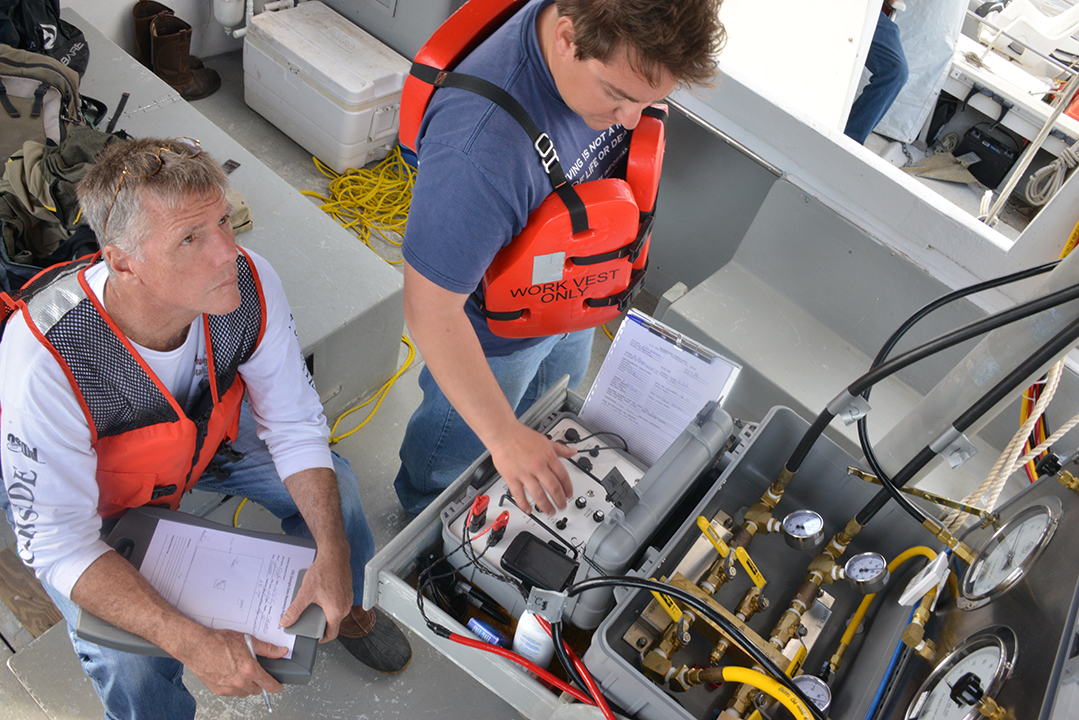 SAVANNAH, Ga. — Each day as tourists saunter through the city’s famous squares, another group of visitors explores a different set of squares at the bottom of the Savannah River.
SAVANNAH, Ga. — Each day as tourists saunter through the city’s famous squares, another group of visitors explores a different set of squares at the bottom of the Savannah River.
For the past two months, a team of 10 marine archaeologists with Panamerican Consultants, Inc., has recovered artifacts from the CSS Georgia, a sunken Civil War-era ironclad near Old Fort Jackson.
The recovery is one part of the Savannah Harbor Expansion Project, which will deepen the river from 42 to 47 feet and allow larger ships to enter the port without being constrained by the fluctuating tides.
The archaeologists’ “squares” are 10-by-10 foot units that comprise a 150-by-250 foot electronic grid, a tool used to map the location of and methodically recover artifacts at the site.
So far, they have collected nearly 500 artifacts from the wreck, including nautical tackle and pieces from a sliding gun carriage. They also brought up two sets of leg irons, which were most likely used by the Confederate navy to restrict mobility of sailors who might desert, according to Jim Jobling, a project manager with Texas A&M University’s Conservation Research Laboratory.
But despite the allure of diving on a sunken wreck, it’s not all gold bullion and priceless artifacts.
“Piles of iron junk. That’s all we’ve been finding for the last few days,” said James Duff, a diver and member of the archaeological team.
The river even seems to conspire against them: Divers wear 5 millimeter thick gloves to protect against the 45-degree water, but this limits their ability to sense objects in the turbid water, where visibility is routinely less than 6 inches. In addition, the optimal diving time is limited to a one- to two-hour period that straddles high or low tide.
But the team has the process down.
After positioning the boat and dropping anchor, a lone diver descends to the bottom and remains tethered by an “umbilical cord” composed of three hard rubber lines. The lines carry oxygen, provide communications and allow archaeologists on the surface to determine the exact depth by sending a shot of pneumatic air.
Once on the bottom, the diver places a wire basket in the middle of one 10-by-10 foot square, and, while holding onto the basket with one hand, uses his other hand and feet to locate objects.
Archaeologists on the surface stay in constant communication with the diver, logging the exact locations of the objects he collects and guiding his movements among squares.
This process can make the recovery process painstakingly slow, but it hasn’t dampened the team’s spirit.
“These types of dives only come around once in a lifetime,” said Stephen James, the lead archaeologist.
The dive on March 4 was typical for the past two months, except for the unusually warm weather. James recorded the objects’ positions as Michael Murray, the diver, reported each discovery to Jeff Pardee, who sat next to James and monitored communications. Matt Elliott tended Murray’s umbilical cord to prevent it from getting tangled, while Will Wilson ran the system used for tracking the diver’s position on the grid.
“At one o’clock, approximately a foot from the basket,” said Murray, his words rhythmically interrupted by Darth Vader-like breaths, “I have a fastener. Exactly one foot long.”
His voice exhibited a hint of excitement when he stumbled upon a mound of silt, but it proved fruitless. Later, Murray detected a triangular object so small that it would slip through the holes in the wire basket and put it in his pocket.
As archaeologists in the boat pulled up the basket, most objects were completely covered in globs of rock and silt called concretions. They placed the objects in bins corresponding to the square in which they were found and later sent them to the team’s field laboratory on shore.
There, Jobling and Parker Brooks, a conservator and graduate student from Texas A&M University, tag and catalogue the artifacts before sending them to the A&M’s Conservation Research Laboratory for further analysis and conservation.
A majority of the objects recovered thus far have been fasteners, which were used to hold the armor, fashioned from railroad iron, to the side of the ship. In addition to artifacts from the CSS Georgia, the team has discovered ceramic pottery that predates European explorers’ arrival in North America.
To the untrained eye, though, it’s difficult to see past the barnacle-covered globs in the basket.
“Stuff will just appear out of concretions,” James said.
Back on shore, Brooks unpacked the boxes and began to catalogue the artifacts. He picked up one object – the small triangular object Murray had placed in his pocket earlier – and gave it a once over.
“Yep, it’s a rock,” he said.
On to the next square.
Visit our Flickr album to see some of the artifacts archaeologists have recovered. The album is continuously updated.